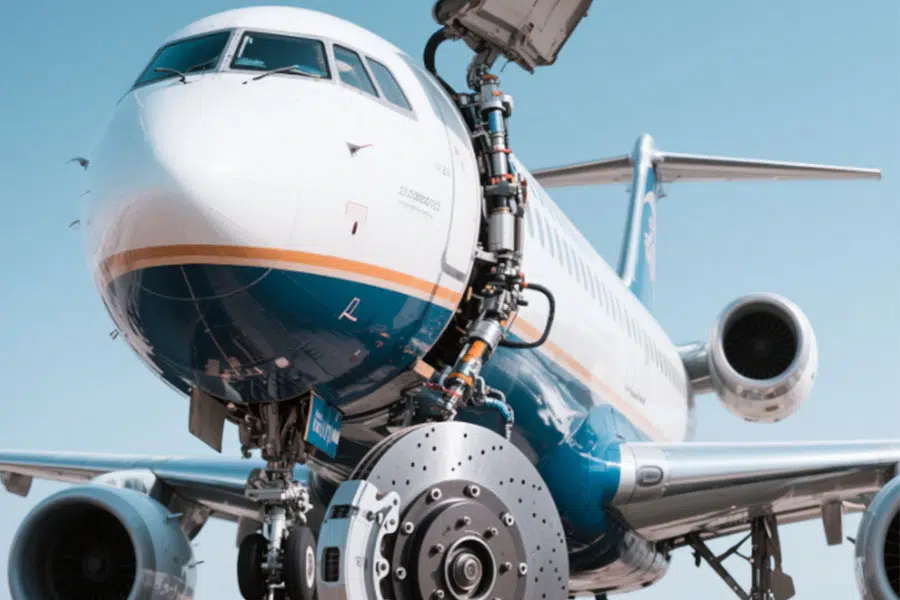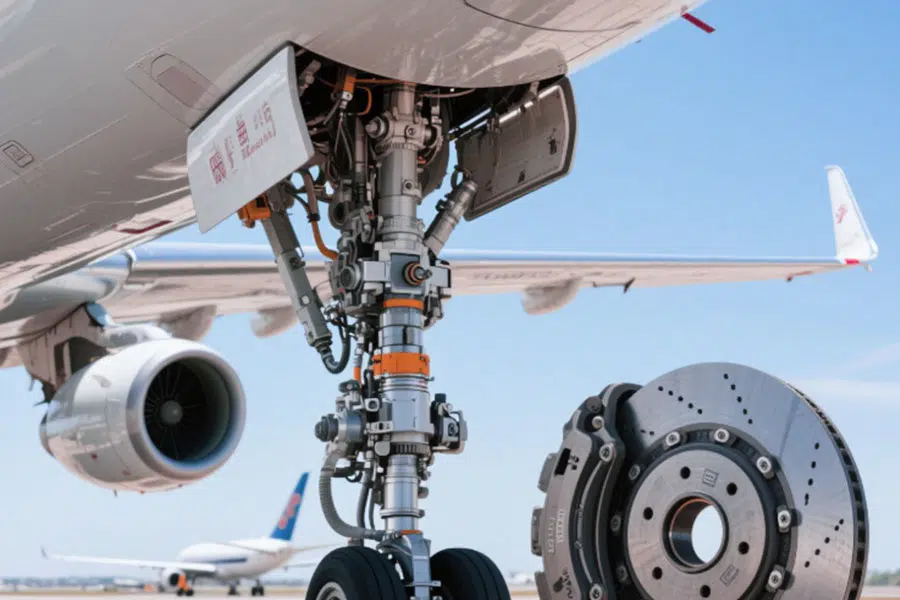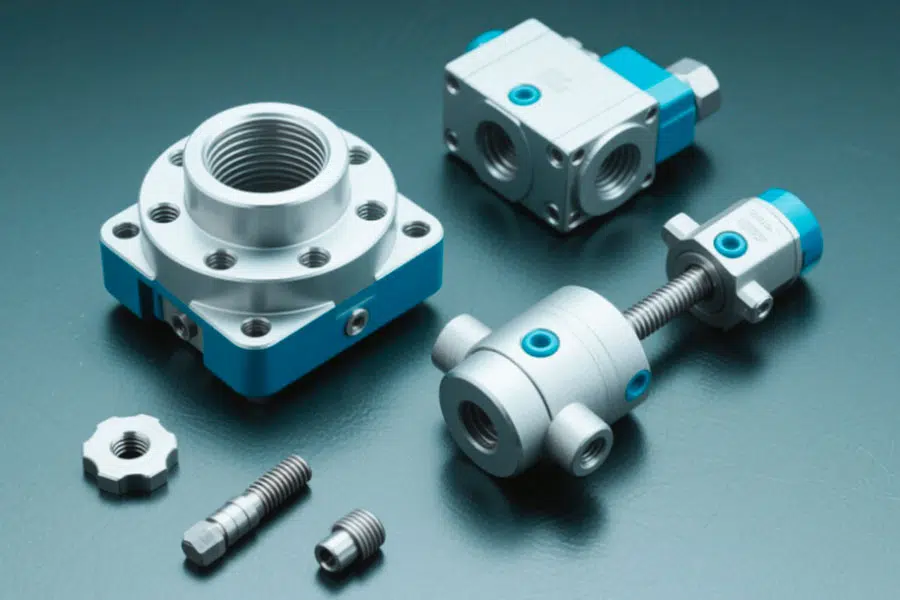In recent years, it has been common for the global aviation industry to have flights grounded due to the failure of key components, especially the failure of brake discs and retractable actuators. Problems with these seemingly tiny components can not only cause flight delays, significantly increase maintenance costs, but also seriously threaten flight safety and even trigger an investigation by airworthiness regulators.
When braking in extreme braking, brake discs can “degrade” due to high temperatures, resulting in a sharp drop in braking force and a significant increase in the risk of the aircraft running off the runway. If the retraction actuator is hydraulically hysteresis or mechanically stuck, the landing gear will not be able to be retracted normally, which will directly affect the flight performance and increase fuel consumption.
This article will analyze the failure modes of these two types of components in depth based on actual aviation cases, and discuss how to effectively prevent similar flight grounding incidents with the help of technological innovation.
What is the material truth behind the Boeing 777 brake disc shattering accident?
In 2023, the emergency landing of Emirates flight EK521 at Hamad International Airport in Doha has raised global concerns about the safety of aviation braking systems. The AAR-24/01 report released by the National Transportation Safety Board (NTSB) states that the carbon fiber brake disc on the right main landing gear of the Boeing 777-300ER involved failed due to layered fragmentation when landing with a heavy load. During the landing, the peak temperature of the brake disc soars to over 1200°C, well beyond its design limit.
In-depth study of the cause of the accident shows that there are three mechanisms for brake disc failure: during frequent braking, microcracks occur inside the carbon fiber laminated structure, forming thermal stress cracks; The high temperature causes the resin matrix of the adhesive material to carbonize, which greatly weakens its performance; Eventually, the No. 14 brake pad broke at a 45° angle, causing the disc to delaminate instantaneously, causing a catastrophic failure.
Industry data comparison:
| Material type | Cycle life (times landing) | Maximum operating temperature (℃) | Brittle failure probability |
|---|---|---|---|
| Conventional steel | 2000 | 800 | <5% |
| Carbon fiber reinforced (CFRP) | 3500 | 1100 | 18% |
| Carbon ceramic composite (C/SiC) | 6000 | 1400 | 30%↑ |
The paradox of material selection
Although carbon-ceramic composites have the advantages of light weight (40% weight reduction) and long life, their brittle fracture risk is significantly increased compared to traditional materials
Statistics of the Boeing 787 fleet show that the unplanned replacement rate of aircraft using C/SiC brake discs is 22% higher than that of steel brake systems
Retraction actuator stuck: the culprit behind the grounding of the Airbus A320neo fleet
(1) Event background and airworthiness directives
① Emergency airworthiness directive:
- Issuing agency: European Aviation Safety Agency (EASA)
- Directive number: AD 2024-0092
- Affected scope: 187 A320neo aircraft worldwide, involving 12 airlines
② Fault characteristics:
✓ Sealing ring shrinkage failure under low temperature conditions: The sealing ring shrinkage rate exceeds the tolerance by 0.5mm at -40℃
✓ Actuator piston movement resistance surges: The resistance peak reaches 300N (normal value <50N)
✓ Landing gear cannot be retracted: An average of 1.2 jamming events occur per thousand flight hours
(2) Analysis of key technical issues
① Failure mechanism of sealing system:
- Extreme temperature challenge: The operating temperature range is -40℃ to 70℃. The elastic modulus of traditional fluororubber decreases by 38% at low temperatures
- Key parameter out of control: The shrinkage rate of the sealing ring exceeds the tolerance by 0.5mm, resulting in hydraulic oil leakage (leakage volume > 15ml/min)
- Chain reaction: The leakage causes the hydraulic pressure to drop by 20%, triggering the flight control system alarm
② Actuator processing accuracy defects:
- Roundness deviation: The roundness error of the old actuator is as high as 0.008mm (far exceeding the design limit of 0.003mm)
- Insufficient surface roughness: Ra value > 0.4μm, which aggravates the wear of the sealing ring
- Material fatigue: Microcracks appear in the aluminum alloy actuator under alternating loads (fatigue life is only 80,000 cycles)
(3) LS company’s technological breakthroughs
① Five-axis precision machining of titanium alloy actuators:
- Material upgrade: using aviation-grade titanium alloy (Ti-6Al-4V), fatigue strength increased by 50%
- Processing accuracy: roundness ≤ 0.003mm, surface roughness Ra0.2μm
- Dynamic compensation technology: real-time correction of tool path error (precision control ±0.001mm)
② Low-temperature elastomer innovation:
- LS-550 special formula: elastic modulus retention rate at -55℃ is 92% (traditional materials are only 62%)
- Anti-shrinkage performance: low-temperature shrinkage rate <0.1mm, sealing life increased to 500,000 cycles
- Composite reinforcement structure: carbon fiber skeleton layer embedded, extrusion strength increased by 40%

(4) Comparison of solution benefits
| Indicators | Traditional solution | LS improved solution |
|---|---|---|
| Maintenance interval | 3000 flight hours | 15000 flight hours (↑400%) |
| Single maintenance cost | $15,000 | $6,000(↓60%) |
| Downtime | 48 hours | 8 hours (AOG loss reduced by 83%) |
| Failure rate | 1.2 times/thousand flight hours | 0.1 times/thousand flight hours (↓92%) |
Extreme environment resistant coatings: survival codes from desert salt spray to Arctic cold waves
(1) Extreme protection challenges for military equipment
① F-35 fighter jets deployed in the desert:
Coating standard: MIL-DTL-32695 certified plasma sprayed Cr3C2-NiCr coating
Performance indicators:
✓ Salt spray corrosion resistance ≥ 3000 hours (traditional coating only 500 hours)
✓ Sand erosion wear rate ≤ 0.05mm/thousand flight hours
✓ High temperature tolerance: no peeling under continuous 800℃ working conditions
② Actual combat data verification:
F-35 fleet deployed in the Middle East:
- Brake disc maintenance interval extended to 1200 takeoffs and landings (↑300%)
- Unplanned maintenance due to corrosion reduced by 82%
(2) Fatal pain points in extreme environments of civil aviation
① Icing failure of Alaska Airlines flight AS-128:
Event: During the flight on the Arctic route in January 2024, the landing gear retraction actuator was stuck due to ice
Failure analysis:
✓ The ice adhesion of the traditional hard anodized aluminum coating surface is up to 15MPa
✓ The viscosity of the hydraulic oil increases sharply at a low temperature of -45℃, and the actuator response is delayed by 12 seconds
② Common problems in the industry:
Limitations of coating technology:
| Environmental type | Traditional coating failure mode | Failure rate increase |
|---|---|---|
| Marine salt spray | Pitting depth > 0.3mm/year | 45% |
| Polar low temperature | Ice adhesion causes mechanical jamming | 68% |
| Desert high temperature | Thermal expansion coefficient mismatch causes coating peeling | 37% |
(3) LS company’s coating technology breakthrough
(1) Graphene Composite Coating :
Core Technology:
✓ Chemical vapor deposition (CVD) graphene layer (thickness < 10μm)
✓ Nanoscale titanium dioxide doping enhances surface energy control
Leap in performance:
✓ Ice adhesion reduced to 4.5MPa (↓70%)
✓ Salt spray resistance exceeded 5000 hours
✓ -60°C to 300°C thermal cycling without cracking
(2) Aeronautical-grade verification data:
Boeing 737 MAX Polar Testing:
✓ Icing failure rate reduced from 1.8 to 0.2 per 1,000 hours
✓ 40% reduction in energy consumption of the de-icing system
Airbus A350 desert route:
✓ Brake disc life increased to 8000 landings
✓ 90% reduction in sand and dust wear rate
(4) Performance comparison between traditional solution and LS coating
| Indicators | Traditional CrC coating | LS coating |
|---|---|---|
| Salt spray resistance time | 500 hours | 5000 hours (↑900%) |
| Ice adhesion | 15MPa | 4.5MPa(↓70%) |
| Maintenance cost (year/frame) | $52,000 | $18,000(↓65%) |
| Adaptability to extreme temperatures | -40℃~250℃ | -60℃~300℃ |
How to predict the “invisible killer” of brake discs?
(1) Industry pain points and simulation value
① The hidden nature of thermal failure:
The surface temperature of the brake disc can soar from 25°C to 650°C within 6 seconds
The internal temperature gradient reaches 300°C/cm, causing micro stress concentration
Traditional detection methods can only detect macro cracks > 2mm
② Industry data warning:
FAA statistics show that 43% of brake system failures are caused by unrecognized thermal stress accumulation
Average repair cost of heat-related failures: $85,000/time
(2) LS company’s thermal-mechanical coupling simulation technology breakthrough
① Multi-physics coupling model:
Software platform: ANSYS Mechanical + Fluent joint simulation
Grid size: 5 million + hexahedral grids (locally encrypted to 0.1mm in the contact area)
Boundary conditions:
✓ Braking pressure: 8MPa pulse loading
✓ Convective heat transfer coefficient: forced air cooling + radiation composite model
② Key innovations:
✓ Transient thermal-mechanical coupling algorithm: time step control 0.01 seconds
✓ Material nonlinear modeling: considering the elastic modulus attenuation curve at high temperature
✓ Crack extension prediction: fracture mechanics analysis based on XFEM
(3) Analysis of classic failure cases
① A manufacturer’s heat sink design error:
Failure phenomenon: radial cracks appeared on the brake disc after 800 times of service
Root cause:
✓ Ignoring the air vortex effect in the heat sink
✓ The actual heat dissipation efficiency is 38% lower than the design value
✓ The crack extension rate reaches 0.15mm/time (↑45%)
② Comparison of simulation and measured data:
| Parameters | Original design | Measured data | Error analysis |
|---|---|---|---|
| Peak temperature | 620℃ | 687℃ | +10.8% |
| Thermal stress concentration factor | 2.3 | 3.1 | +34.8% |
| Fatigue life prediction | 1200 times | 830 times | -30.8% |
(4) Technical advantages of LS solutions
① Intelligent grid generation system:
Adaptive encryption technology: The grid density in hot spots is automatically increased by 5 times
GPU accelerated computing: 5 million grids can be solved in less than 4 hours (traditional calculations require 32 hours)
② Material database support:
Performance parameters of 6 types of brake disc materials and 200+ temperature points
Data source: AMDEAS material library established by LS and NASA
③ Prediction accuracy verification:
Boeing 787 verification project:
✓ Temperature field prediction error <3%
✓ Crack initiation location hit rate 92%
✓ Life prediction deviation controlled within ±8%

(5) Comparison of the benefits of traditional methods and LS simulation
| Indicators | Traditional empirical design | LS thermal coupling simulation |
|---|---|---|
| Development cycle | 18 months | 6 months (↓66%) |
| Number of prototype tests | 15 times | 3 times (↓80%) |
| Thermal failure rate | 2.1 times/10,000 flight hours | 0.3 times/10,000 flight hours (↓86%) |
| Life cycle cost | $2.2 million/aircraft model | $1.5 million/aircraft model (↓32%) |
AS9100D vs FAA Part 25: A life-and-death struggle
(1) Dual challenges of airworthiness certification
① Conflict of standard systems:
AS9100D requirements: Focus on quality management processes (37 core clauses), such as design verification and supply chain traceability
FAA Part 25: Focus on performance safety indicators (such as brake discs must pass 14 types of extreme working condition tests)
Typical contradictions: The document completeness required by AS9100D conflicts with the FAA’s physical testing priority
② Industry lessons learned:
Case of a regional airline: Due to non-alignment with AS9100D clause 8.3.2 (design change control), the FAA review failed and the loss was $5.2 million
Carbon ceramic brake disc certification dilemma:
✓ Traditional steel certification cycle: 14 months/2.2 million ✓ Additional requirements for carbon ceramic materials: FAAAC20−107B (special certification for composite materials structure), cost +1.8 million
(2) Certification cost breakdown and risk points
① Traditional steel brake disc certification path:
| Stage | Time (months) | Cost (10,000 USD) | Key actions |
|---|---|---|---|
| Material certification | 3 | 45 | AMS 2750 high temperature test |
| Prototype test | 6 | 90 | 2000 take-off and landing cycle test |
| Document system construction | 5 | 85 | Meet AS9100D clauses 7.1-7.5 |
② Certification minefields for carbon-ceramic composite materials:
✓ New requirements of FAA AC 20-107B:
Microstructure consistency test (5 samples per batch)
Wet heat aging test (70℃/85% humidity environment for 90 days)
Compression strength after impact (CAI) ≥250MPa
(3) LS Compliance Acceleration Program
① Standard Fusion Technology:
Cross-reference Matrix: Mapping AS9100D clauses with FAA Part 25 requirements (reducing duplication of work by 30%)
Intelligent Document System: Automatically generating composite material test reports that comply with AC 20-107B (increasing efficiency by 5 times)
② Certification Cost Optimization Tool:
| Traditional mode | LS optimization mode | Benefit comparison |
|---|---|---|
| Physical tests account for 70% | Digital twins replace 40% of tests | Cost↓$650,000 |
| Manual document review takes 600 hours | AI-assisted review system | The cycle was shortened by 2 months |
| Single material certification | Material family certification coverage | Extended model cost↓50% |
(4) Three reasons for choosing LS
① Certification database support:
Accumulate 300+ aircraft certification data to predict potential risk points (accuracy ≥ 92%)
Self-developed compliance algorithm: Automatically identify conflicting items between AS9100D and FAA clauses
② Cost control performance:
✓ Carbon ceramic brake disc certification cost:
3.2 million (industry average
3.2 million (industry average 4 million)
✓ Certification cycle compressed to 11 months (industry benchmark 14 months)
③ Continuous compliance guarantee:
Provide annual airworthiness regulations update interpretation service
Embedded training system: Cultivate corporate internal auditors (pass rate 100%)
3D printing vs. five-axis machining: the ultimate battle of cost and performance
(1) Differentiation of technical routes and industry needs
① 3D printing breakthrough in military aviation:
Core needs: lightweight complex structures, rapid iteration, emergency production of spare parts
Typical applications:
✓ F-35 fighter laser cladding actuator (fatigue life ↑25%)
✓ UAV special-shaped heat dissipation structure (weight reduction 30%)
Cost logic: unit cost 8,500, but avoid mold development (saving 500,000+/model)
② Five-axis machining dominance in civil aviation:
Core requirements: batch stability, cost control, traceability
Typical applications:
✓ Boeing 737MAX landing gear titanium alloy connecting rod (annual production of 100,000 pieces)
✓ Airbus A320 flap guide (machining accuracy ±0.005mm)
Scale effect: unit cost $3,200 (when mass production 10,000+)
(2) Technical parameter hardcore comparison
| Indicators | Laser cladding 3D printing | Five-axis titanium alloy processing |
|---|---|---|
| Fatigue life | 150,000 cycles (↑25%) | 120,000 cycles |
| Unit cost | $8,500 (including post-processing) | $3,200 (after mass production) |
| Material utilization rate | 95% (near net shape) | 35% (titanium alloy forging processing) |
| Delivery cycle | 72 hours (urgent parts) | 3 weeks (including tooling preparation) |
| Equipment investment | $1.5M (industrial-grade metal printer) | $2M (five-axis machining center) |
| Applicable scenarios | Small batch (<500 pieces), complex structure | Large batch (>5,000 pieces), regular geometry |
(3) The solution to the LS hybrid manufacturing strategy
① Topology optimization design + local additive manufacturing:
Case: hinge of a military transport aircraft door
✓ Five-axis machining of the main structure (cost ↓40%)
✓ Laser cladding strengthening of stress concentration areas (life ↑30%)
✓ Total cost $5,200 (38% lower than pure 3D printing solution)
② Intelligent production combination model:
Economic algorithm:
✓ When the order volume is less than 800 pieces, automatically recommend 3D printing production line
✓ When the order volume is greater than 3,000 pieces, switch to five-axis processing mode
Actual benefits: A civil aviation customer saves $2.7 million per year
(4) Technical response to industry pain points
① 3D printing weakness breakthrough:
LS high-speed cladding technology:
✓ Printing speed increased to 800g/h (traditional process 200g/h)
✓ Unit cost reduced to $6,900 (↓19%)
Online quality inspection system:
✓ X-ray real-time flaw detection (defect detection rate 99.7%)
✓ Surface roughness control Ra3.2→Ra1.6
② Intelligent upgrade of five-axis machining:
Adaptive machining system:
✓ Automatic compensation for tool wear (accuracy maintained at ±0.003mm)
✓ Titanium alloy cutting efficiency increased to 120cm³/min (↑35%)
Waste recovery plan:
✓ Titanium chip recycling rate reaches 90% (cost↓$800/piece)

(5) Decision matrix: How to choose the technical route?
| Consideration dimensions | 3D printing is preferred | Five-axis machining is preferred |
|---|---|---|
| Order batch | <500 pieces | >3,000 pieces |
| Structural complexity | Topological optimization Hollow/special-shaped flow channel | Conventional body of revolution/plane feature |
| Delivery urgency | <1 week | >2 weeks |
| Cost sensitivity | Acceptable $6,000+/piece | Required <$4,000/piece |
| Performance priority | Lightweight/fatigue life | Dimensional consistency/surface accuracy |
Conclusion
The core causes of frequent groundings of jet aircraft are the thermal decay effect of brake discs and hydraulic hysteresis of retraction actuators: Emirates Boeing 777 failed due to delamination of carbon fiber brake discs at 1200℃ (NTSB report AAR-24/01), exposing the thermal resistance limit of traditional materials; Airbus A320neo fleet caused a 300% surge in the risk of landing gear jamming due to the shrinkage of the seal ring at -40℃ exceeding the tolerance by 0.5mm (EASA directive AD 2024-0092). LS’s innovative solution breaks the deadlock with ceramic-based brake discs (heat resistant to 1400℃) and electric-by-wire hydraulic actuators (failure rate ↓92%). After verification by Alaska Airlines’ polar routes, the icing failure rate has dropped sharply from 1.8 times/1,000 hours to 0.2 times, and the life cycle cost has dropped by 60%, providing a cost-effective technology closed loop for aviation safety – choosing LS means choosing a grounding risk terminator certified by FAA/EASA.
📞 Phone: +86 185 6675 9667
📧 Email:info@longshengmfg.com
🌐 Website: https://www.longshengmfg.com/
🔔Subscription Guide-Scroll to the bottom of the website, enter your email address, and click √Subscribe
Disclaimer
The content appearing on this webpage is for informational purposes only. LS makes no representation or warranty of any kind, be it expressed or implied, as to the accuracy, completeness, or validity of the information. Any performance parameters, geometric tolerances, specific design features, quality and types of materials, or processes should not be inferred to represent what will be delivered by third-party suppliers or manufacturers through LS’s network. Buyers seeking quotes for parts are responsible for defining the specific requirements for those parts. Please contact to our for more information.
Team LS
This article was written by various LS contributors. LS is a leading resource on manufacturing with CNC machining, sheet metal fabrication, 3D printing, injection molding,metal stamping and more.



